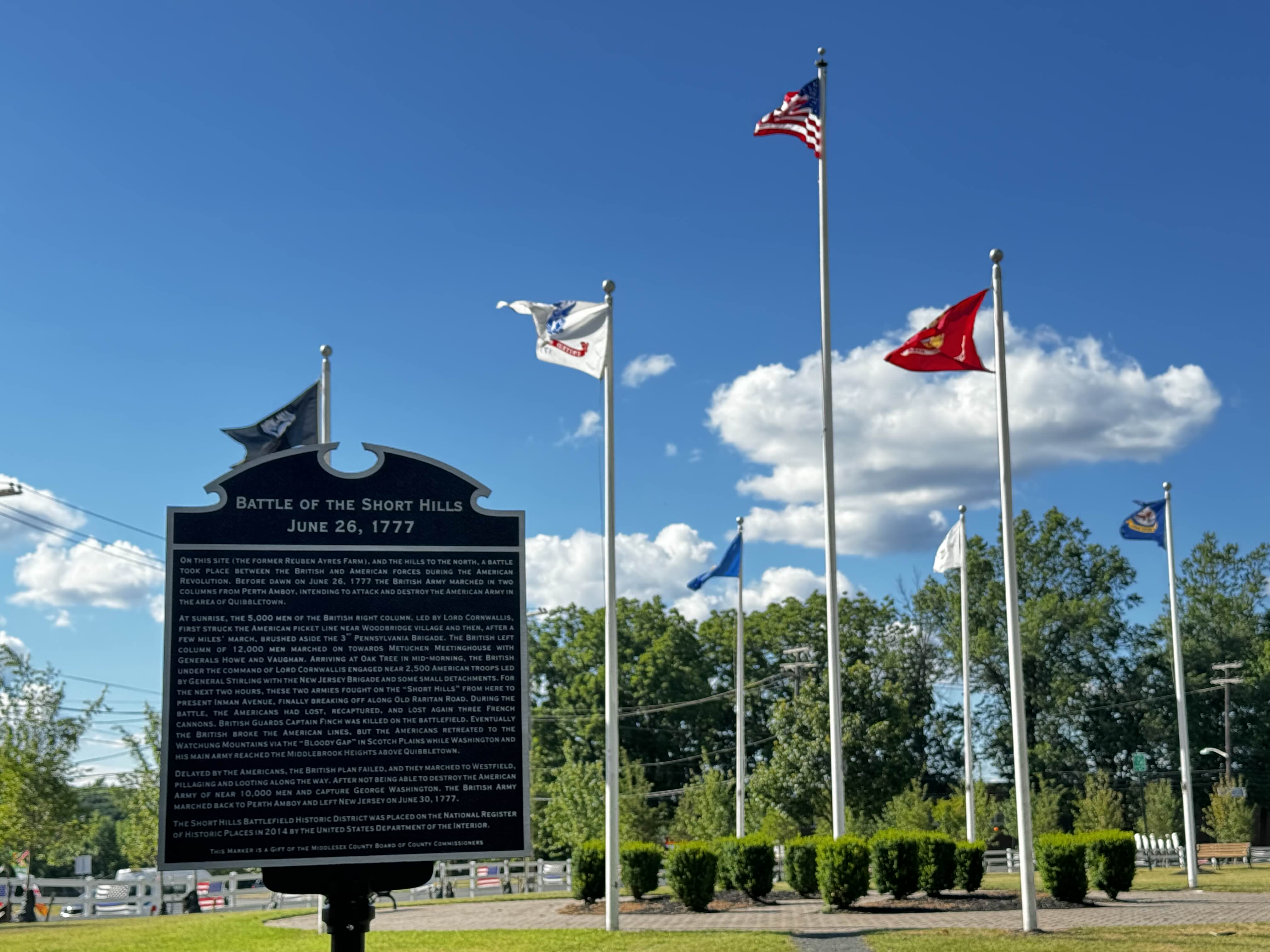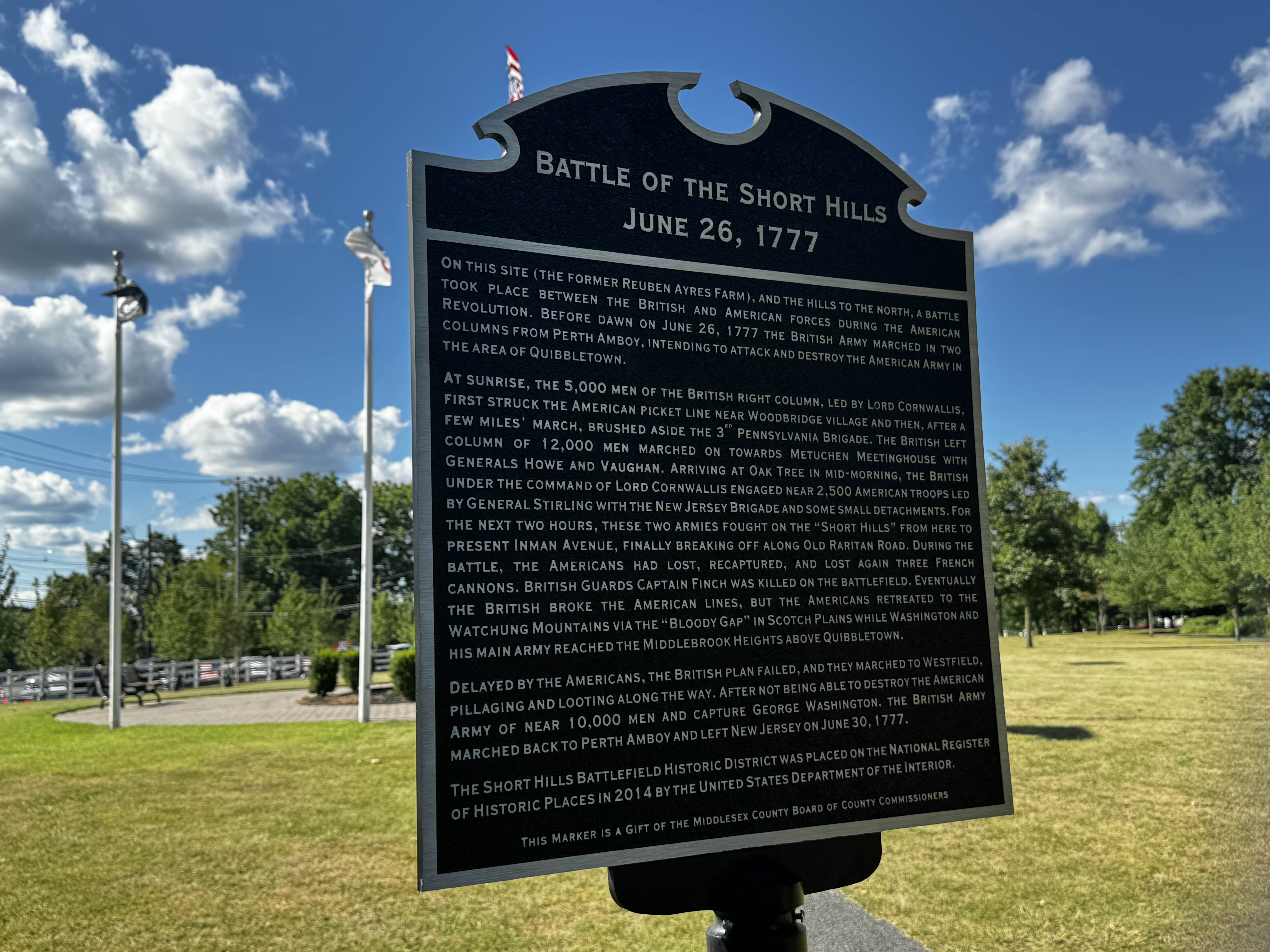Oak Tree Pond receives American Revolutionary War historical marker

A view of the new historical marker for the Battle of the Short Hills with flags of the various American military branches in the background at Oak Tree Pond Historic Park. ZFJ/Zoe Wu
EDISON, N.J., July 2 (ZFJ) — Edison unveiled a new sign commemorating the Battle of Short Hills at Oak Tree Pond Historic Park on Wednesday, June 26.
The sign, installed 250 years after the American Revolutionary War battle, was a gift from the Middlesex County Board of County Commissioners.
The Short Hills Battlefield Historic District was placed on the National Register of Historic Places in 2014 by the U.S. Department of the Interior.
SETTING THE STAGE FOR BATTLE
By early 1777, General George Washington was able to reverse an earlier retreat after winning battles at Trenton and Princeton and established headquarters at Morristown. His army conducted operations in the area of Watchung Heights for several months.
By mid-June 1777, British General Sir William Howe rallied his main army of about 17,000 men in the Raritan Valley area and formulated a plan to destroy Washington’s army of 8,000 and capture Philadelphia. He initially pretended to advance towards the Delaware River in an attempt to lure Washington into an open area by Somerset Courthouse, but that failed, so on June 21, he began withdrawing his troops from New Brunswick.
Washington attacked the rear of Howe’s army in Piscataway and Bonhamtown. He then moved headquarters to the less-protected plains at Quibbletown (northern Piscataway).
On the evening of June 25, Howe received intelligence that Washington had moved to the low ground—a vulnerable position. He divided his army in half to launch a two-pronged pincer attack.
EVENTS OF THE BATTLE
General Lord Charles Cornwallis, commanding the right column of 5,000 men, departed Amboy at sunrise on June 26, traveling through Woodbridge to Scotch Plains.
General John Vaughan and Howe, commanding the left column of nearly 12,000 men, departed later, marching along the present-day Plainfield Road to Metuchen Meetinghouse. Their plan was to join the rear of Cornwallis’ column to cut off the Americans’ retreat and force Washington to fight on open ground in Piscataway and Woodbridge.
Before sunrise, in the first skirmish of the day, Cornwallis encountered American pickets near Woodbridge Village at the present-day Green Street and Route 1. The detachment of New Jersey and Virginia troops posted there with Colonel Daniel Morgan’s Rifle Corps were forced to retreat.
Brigadier General Thomas Conway’s 3rd Pennsylvania Brigade, numbering about 700 men and commanded by New Jersey Brigadier General William Maxwell, was alerted by the sound of firing and arrived. They met the British on high ground near Oak Tree Road and Wood Avenue but were far outnumbered and forced to retreat, allowing Cornwallis to continue.
 A closer view of the new historical marker at Oak Tree Pond Historic Park commemorating the Battle of Short Hills. ZFJ/Zoe Wu
A closer view of the new historical marker at Oak Tree Pond Historic Park commemorating the Battle of Short Hills. ZFJ/Zoe Wu
Between 8:30-9.00 a.m., the Oak Tree Engagement began in the present-day Oak Tree Pond and continued between New Dover Road and Woodland Avenue. Colonel Charles Armand’s “Otlendorf’s Corps” lost 32 of 80 men but saved an American cannon.
The New Jersey Brigade, consisting of about 1,000 men and four cannons and commanded by General Lord Stirling, assembled near Short Hills Tavern (Old Raritan Road and Inman Avenue) and formed a line stretching east towards Tingley Lane and Rahway Road. They moved south and engaged British and Hessian elite troops.
For two hours, the Americans fought on the “short hills” in the battle’s largest engagement, outnumbered five to one. They were eventually forced to retreat to Westfield, then the First Watchung Mountain via the “Bloody Gap” in Scotch Plains.
The Americans sustained almost 200 casualties and lost three French cannons but delayed the British long enough for Washington to reposition his army from Howe’s trap to the Middlebrook Heights above Quibbletown, saving it.
The British sustained few casualties but lost one officer—Guards Captain John Finch. Foiled, they marched to Westfield, looting along the way. During this pillaging, the one and a half story farmhouse at Oak Tree Pond—owned by Reuben Ayres, an American militia member—was burned down.
The British failed to capture Washington and destroy his army. They marched back to Perth Amboy and left New Jersey on June 30, 1777.
References
- Edison Township - @edisontownshipgovernment - @mayorsamjoshi and members of the Edison Council unveiled a new Battle of Short Hills sign at Oak Tree Pond alongside various stakeholders and a performance by the JP Steven’s Brass Ensemble and a beautiful National Anthem sung by Amy Boslet of the Edison High School Choir. - https://www.instagram.com/p/C8r79WXu5qs/?img_index=1
